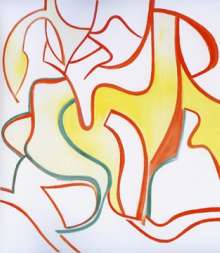 This morning I was mowing down some of our meadow. All around our little house in the woods there’s a swath of grasses and flowers that gets mowed once a year, in late fall. And after the tall stuff is gone, bright green mosses are revealed in many patches. After three hours outdoors, I practiced Chopin’s Polonaise-fantaisie and some Haydn (for Taiwan in two weeks, where it will go with Bussotti and Curran). There wasn’t really enough time at the piano or outside. Perhaps somebody else should cut the rest of the meadow?….
This morning I was mowing down some of our meadow. All around our little house in the woods there’s a swath of grasses and flowers that gets mowed once a year, in late fall. And after the tall stuff is gone, bright green mosses are revealed in many patches. After three hours outdoors, I practiced Chopin’s Polonaise-fantaisie and some Haydn (for Taiwan in two weeks, where it will go with Bussotti and Curran). There wasn’t really enough time at the piano or outside. Perhaps somebody else should cut the rest of the meadow?….
In the early afternoon, I went on the train to Boston to my school office to start putting together the programs for New England Conservatory’s series of performances of all of Haydn’s piano sonatas in Boston, and for a related series at the L.A. County Museum. This is a lot of music that is unfamiliar and a bit that’s very familiar. How many “sonatas” by Haydn are there? I’m still counting–and recounting (and this isn’t even Minnesota). Haydn didn’t begin using the term “sonata” until 1771 (in the score of Hoboken XVI: 20 in C Minor). There are pieces titled “Partita” (and “Parthia”) and “Divertimento.” The categorization of all these pieces, in the nineteenth century, as belonging to work group XVI (Klaviersonaten) in Hoboken’s catalogue was a musicological act of revisionist history!
And there are questions of “authenticity.” Some pieces frequently included in past publications of Haydn’s sonatas now seem to be music written by other people. There are some outright fakes. We have just the beginnings of six early sonatas that are lost. In 1993, they were found — but it turned out a forger took Haydn’s opening measures and went from there. In the eighteenth-century, copyright was new. The concept of artistic “ownership” was beginning. But people appropriated and borrowed and “stole.” The whole issue of connoisseurship is an aspect of this project. In a museum, we are interested to see works from the “School of Rubens” In classical music, there’s obsession with “masterpieces” written by “geniuses.” In 1995, the Metropolitan Museum of Art’s exhibition “Rembrandt/Not Rembrandt” raised many questions. And Foucault opines: “It would be worth examining how the author became individualized in a culture like ours, what status he has been given, at what moment studies of authenticity and attribution began, in what kind of system of valorization the author was involved, at what point we began to recount the lives of authors rather than of heroes…”
In a few days it will be Elliott Carter’s 100th birthday. In Boston, there are many performances of Carter’s music, including a lot this week at New England Conservatory. Tonight, I am hearing at least part of an all-Carter program in Jordan Hall. There’s a new piece for six percussionists, Tintinnabulation. Larry Lesser and Christopher Taylor are playing the 1948 cello and piano sonata. They play it great! I couldn’t imagine that I really wanted to hear this piece. It’s not new music in any sense. It’s been well played often enough. But this was transparent in a lovely way. This is repertoire now. And there are so many allusions (intertexts)? Was that a celebrated mazurka by Chopin in the slow movement? Is that Beethoven’s D-Major cello sonata in the fugue? I was in a seat underneath the overhang of the balcony, and the sound was perhaps even better elsewhere. The new percussion piece is music that’s always changing — one timbre morphs into another. One rhythm dominates for a patch, then something else grows over it. Frank Epstein (who directed) brings a level of artistry to percussion playing that’s a revelation.
Am I the only person in Jordan Hall who doubts Elliott Carter’s overwhelming musical significance? In his program note, John Heiss writes: “He is in a creative ‘zone,’ reached only by a handful of his predecessors who have been so original, fruitful, and abundantly productive in their later years: Schütz, Bach, Haydn, Beethoven, Verdi, Stravinsky, and now Elliott.”
Undeniably there’s something life-affirming about hearing a remarkably complex piece of new music written by a hundred-year-old man who’s sitting in the same room and smiling! Who couldn’t love that? And I’m wondering, do I just like better the music of people I actually know? (I’ve never really become acquainted with Carter.) Does the music of Babbitt or Cage speak to me because I spoke with them? Babbitt’s string quartets were absolutely compelling in New York at Miller Theater, three weeks ago. And he seemed well and spunky. And, of course, Mr. Carter was there to hear the concert!
Carter’s music is complicated. And that’s always the sign of something important. Or is simplicity better? Or both? Or whatever fits? Or just whatever happens to happen? Is Carter’s music simpler now? Probably. The complexities of the older pieces are fading in new performances, and the new stuff is unlike the dense piling up of information in the 1960s music. The 2007 Horn Concerto appealed right away. It’s a truism — old artists make art that’s pared down, essentialized (de Kooning). Still, I “enjoyed” more the Earle Brown piece we did at Harvard a month ago — but then I knew the guy…..
